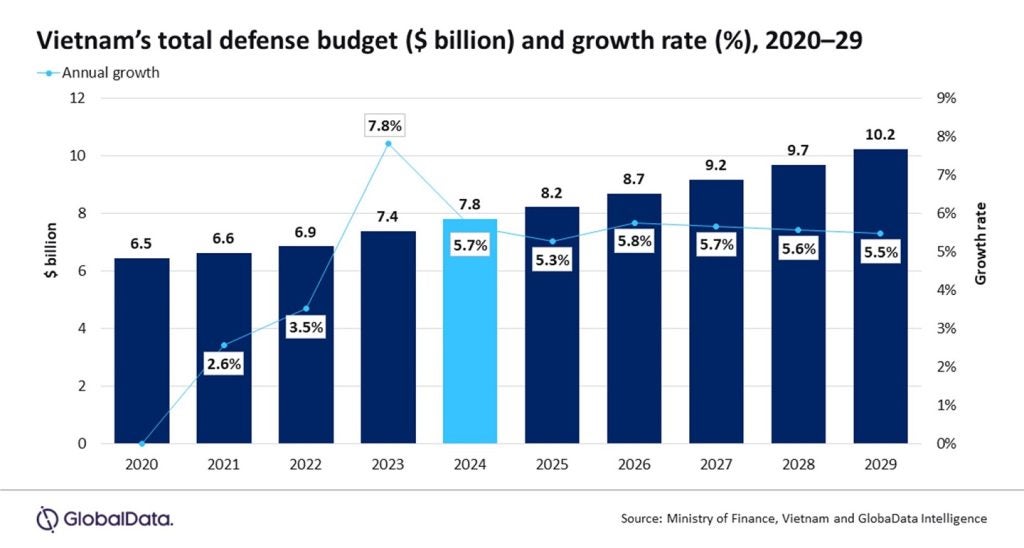
As Vietnam intensifies efforts to modernise its military in response to rising territorial disputes and China’s military expansion, GlobalData’s latest Vietnam defence market report projects an increase in defence spending over the next five years.
Vietnam-China relations and tensions
GlobalData’s comprehensive analysis outlined that Vietnam’s defence budget is expected to witness a compound annual growth rate (CAGR) of 5.6%, surging to an estimated $10.2bn by 2029. This projected uptick shows Vietnam’s commitment to enhancing its military readiness and counterbalancing China’s regional influence.

In 2020, China’s announcement of military exercises near the Paracel Islands highlighted its ongoing sovereignty claims in the South China Sea, sparking tensions with neighbouring countries like Vietnam. While China faced dissent over its exercises, it continued to assert its economic and strategic interests.
When China announced the establishment of administrative districts in the disputed Spratly and Paracel islands, the Vietnamese government complained and accused China of ‘seriously violating’ its sovereignty in the South China Sea.
China rejected the International Court of Justice’s ruling on the South China Sea and is proceeding to fortify several islands with HQ-9 long-range air defence systems and base its J-11 fighter planes on newly created artificial islands, as per GlobalData’s “Vietnam Defence Market 2024-2029” report.
Akash Pratim Debbarma, aerospace and defence analyst at GlobalData, underscores the enduring tension between Vietnam and China, “Ever since the Vietnam-China war of 1979, the relationship between the two countries has always remained strained owing to China’s continuous intrusions in territories of the South China Sea that Vietnam perceives as its own and considers it a threat to its sovereignty.
How well do you really know your competitors?
Access the most comprehensive Company Profiles on the market, powered by GlobalData. Save hours of research. Gain competitive edge.

Thank you!
Your download email will arrive shortly
Not ready to buy yet? Download a free sample
We are confident about the unique quality of our Company Profiles. However, we want you to make the most beneficial decision for your business, so we offer a free sample that you can download by submitting the below form
By GlobalDataEven though Vietnam and China agreed to step up cooperation on security matters in December last year [2023], their relationship is unlikely to significantly improve in the near term.”
Vietnam’s position in Southeast Asia
Key areas of focus in Vietnam’s modernisation drive include enhancing artillery systems, missile defence capabilities, and military aircraft inventory. With a planned procurement of 12 units of Su-57 aircraft from Russia, Vietnam aims to bolster its aerial combat capabilities. Including Su-57s alongside the existing fleet of Su-27 and Su-30 multi-role aircraft shows Vietnam’s commitment to modernising its Air Force inventory.
Vietnam has 24 Su-30MK2, procured during 2003–14. As per GlobalData’s intelligence on the Vietnamese defence market, Vietnam is the third largest flanker operator in Asia after India and China.
Debbarma emphasises Vietnam’s emergence as one of the fastest-growing military powers in Southeast Asia, alongside Malaysia and Indonesia. “As most Southeast Asian countries continue to invest more in their defence budgets to make themselves stronger in order to protect their territory and maintain sovereignty, Vietnam, with an expected cumulative defence budget of $46bn between 2025 and 2029, displays its intent to modernise its defence capabilities to deter hostile forces in the region.”
In a region where defence spending is rising, Vietnam’s strategic investments underscore its determination to deter hostile forces and maintain sovereignty in the face of escalating geopolitical challenges.



